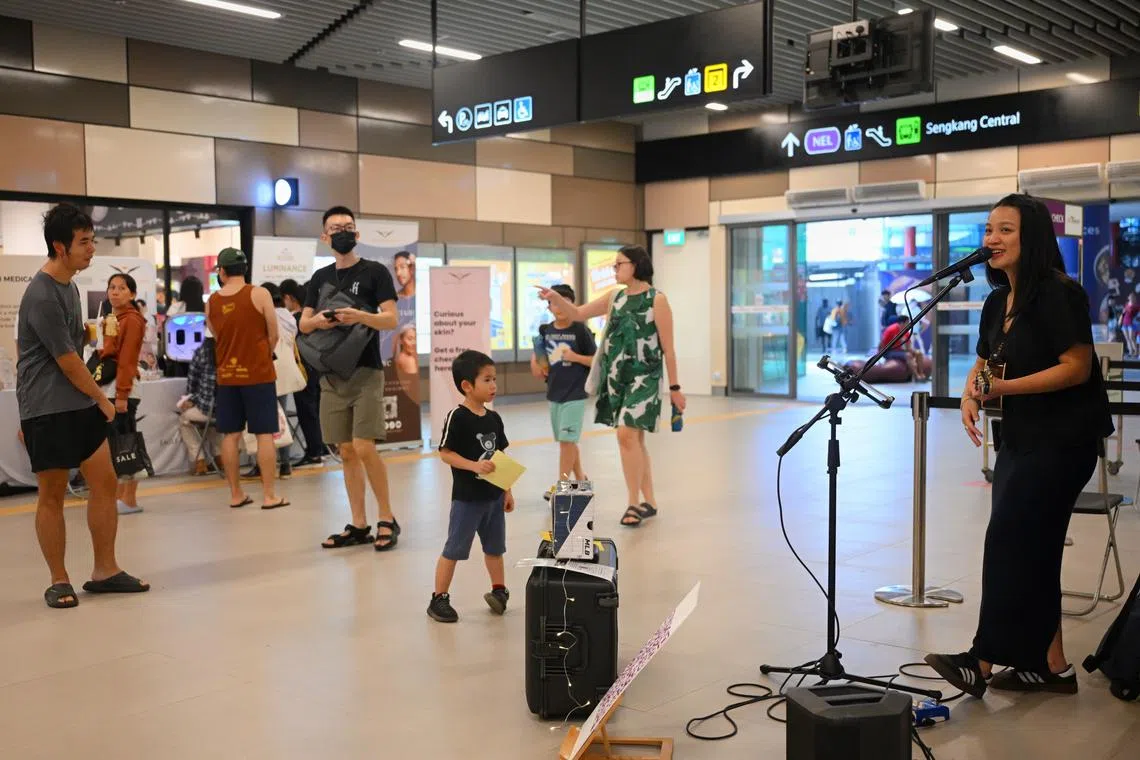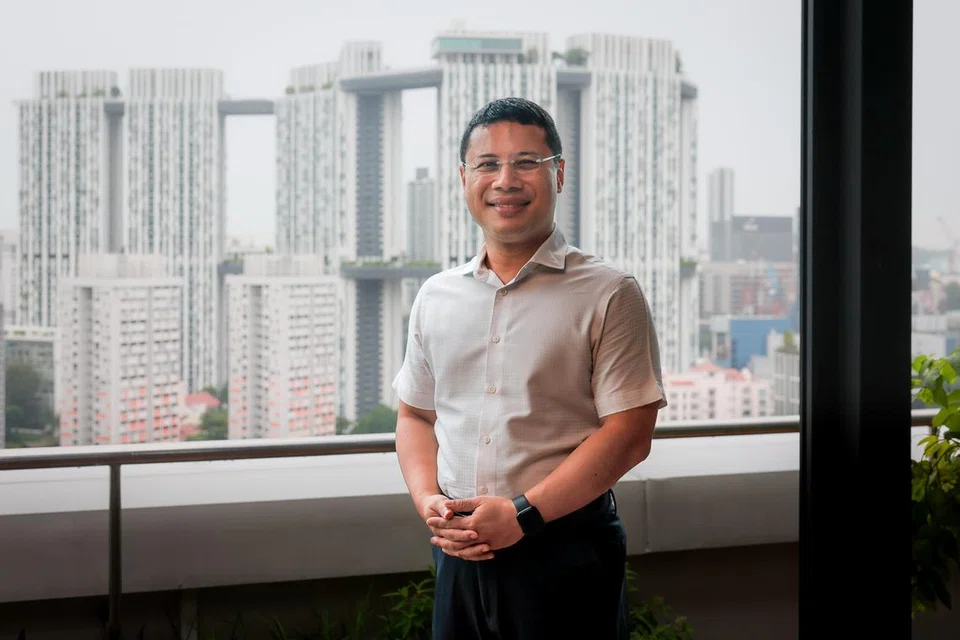Singaporean households can now claim $300 CDC vouchers, half for use at supermarkets
A total of 1.33 million households will benefit from this sixth tranche of CDC vouchers.ST PHOTO: NG SOR LUAN
Chin Soo Fang
Jan 04, 2025
SINGAPORE – Every Singaporean household can now claim $300 worth of CDC vouchers to help them alleviate daily expenses.
Half of the vouchers can be used at supermarkets, and half at participating hawker stalls and heartland merchants.
They are valid until Dec 31.
A total of 1.33 million households will benefit from this sixth tranche of CDC vouchers, which can be used at 23,000 heartland merchants’ stores and hawker stalls; and eight supermarket chains, with about 400 outlets involved.
The latest tranche of vouchers is part of
enhancements to the Assurance Package to help cushion the impact of cost-of-living increases. The first half – $300 in CDC vouchers – was disbursed in June 2024.
Deputy Prime Minister Gan Kim Yong attended the launch of the vouchers at Marine Parade Town Centre on Jan 3, along with Manpower Minister Tan See Leng, who is an MP for Marine Parade GRC.
The event was hosted by the five mayors – Ms Low Yen Ling, Ms Denise Phua, Mr Desmond Choo, Mr Alex Yam and Mr Mohd Fahmi Aliman.
In his speech, Mr Gan, who is also Minister for Trade and Industry, said the launch is one of the first events in 2025 by the Community Development Councils (CDCs) to kick off
Singapore’s diamond jubilee, or SG60, celebrations.
The CDC vouchers are one of the key initiatives in the Government’s efforts to help households manage cost-of-living challenges, he said.
The scheme was introduced during the Covid-19 pandemic to show appreciation to Singaporeans for their solidarity during those difficult times, and to support businesses.
It was continued post-pandemic to help Singaporeans cushion the impact of rising prices.
In 2024, each Singaporean household received
$800 worth of vouchers, with a tranche of $500 in January and $300 in June.
As at Dec 31, 2024, about 97 per cent of Singaporean households have claimed the CDC vouchers for the year.
Of these claimed vouchers, more than $1 billion, or 97.5 per cent, has been spent at participating hawkers, heartland merchants and supermarkets.
Overall, around $1.6 billion has been spent since the launch of the digital CDC vouchers scheme in
December 2021 – $907 million at participating hawkers and heartland merchants, and $689 million at participating supermarkets.
“Thankfully, inflation has cooled in recent months... and barring any unforeseen circumstances, core inflation is expected to ease further to 1.5 per cent to 2.5 per cent this year,” said Mr Gan.
“Even though prices may not be rising as fast, we understand that Singaporeans remain concerned about cost of living,” he added.
“We have taken several measures to address these concerns, and we stand ready to do more to support Singaporeans if necessary.”
He added: “Our strong Singapore dollar enables us to mitigate increases in the costs of imported goods and services. We work with businesses too to drive productivity and innovation, so that Singaporeans can continue to have good jobs with better wages.”
Deputy Prime Minister Gan Kim Yong paying for Chinese New Year goodies at Marine Parade Central Market and Food Centre on Jan 3.ST PHOTO: NG SOR LUAN
Speaking to the media after the launch, Ms Low, who is Senior Minister of State for Trade and Industry, and Culture, Community and Youth, said a total of $1.008 billion of the 2024 vouchers has been spent.
Of this figure, $500 million was spent at heartland merchants, while $508 million was used at supermarkets.
About two-thirds of the amount spent at heartland merchants and hawkers, or $331 million, was spent on food and beverages, including at coffee shops, cafes and hawker stalls.
Another $72 million was spent at heartland minimarts, and the remaining $95 million went to other trades such as salons and stationery shops, said Ms Low, who is also chairwoman of the Mayors’ Committee and Mayor of South West District.
Mr Gan said various measures to cushion the pace of price increases for individuals and households have been rolled out too.
For example, as part of the Assurance Package, all adult Singaporeans received up to $600 in cash in December 2024.
In January, eligible households will get
additional U-Save rebates to help with their utility bills, and rebates for their service and conservancy charges.
Mr Gan said the community and the private sector – including merchant and heartland associations, schools and volunteers – have come forward to support efforts such as the CDC vouchers scheme.
Coffee shop operators have been included as participating merchants in the scheme, he added.
To date, there are about 600 coffee shop stalls that provide budget meal options and accept CDC vouchers.
“The positive impact of the CDC vouchers scheme is a good showcase of what we can achieve by having the public and private sectors working together,” Mr Gan said.
As the nation celebrates SG60, the Government, community and businesses can continue to find ways to work together to take Singapore forward, he added.
To mark SG60, some participating supermarkets, heartland merchants and hawkers are offering promotions for the use of the vouchers.
For example, some heartland merchants and hawkers will provide additional discounts or gifts for customers who use CDC vouchers at their stores to help Singaporeans stretch their dollar.
Supermarkets such as Cold Storage, Giant, FairPrice and Prime Supermarket will also be running in-house promotions for customers using CDC vouchers.
Human resources professional Victoria Ng, 36, said $300 is a “considerable sum” and will help families with rising costs of groceries and food.
“It’s good that more places are accepting CDC vouchers, including hawker centres, hair salons and neighbourhood stores,” she said.
“More people will also be inclined to spend at neighbourhood stores, which is a win-win situation for both customers and merchants.”
How to claim your vouchers
Singaporean households will receive a notification letter by mail with instructions on how to claim and spend their CDC vouchers.
Similar to previous tranches, only one household member needs to visit
go.gov.sg/cdcv and log in with his or her Singpass to claim the digital vouchers on behalf of the household.
Once the vouchers are claimed, the claimant will receive an SMS with a unique voucher link sent from “gov.sg” to the person’s registered mobile number.
This link, which is different from those of previous tranches, can be conveniently shared with other household members.
Those who face difficulties with the digital process can seek help at community centres or clubs (CCs) and SG Digital Community Hubs. There will be priority queues at CCs for seniors and people with disabilities.
Help will be provided for residents without smartphones or those who need help setting up Singpass accounts or resetting passwords.
Over the first two weeks of the launch, close to 450 youth and student volunteers from institutions, such as ITE College Central, Republic Polytechnic and St Joseph’s Institution, will assist residents at selected CCs alongside CDC ambassadors.
SG Digital Office’s digital ambassadors and Silver Infocomm wellness ambassadors will be stationed at CCs to help residents claim their digital vouchers from Jan 3 to 16.
Residents are reminded to guard against scams.
Claiming the CDC vouchers does not require any involvement with bank applications or transactions.
Those who encounter any suspicious messages relating to gov.sg or CDC vouchers can contact the People’s Association on 6225-5322, or submit the information online at
police.gov.sg/i-witness or call 1800-255-0000 to make a police report.
More details on January’s CDC vouchers scheme can be found at
vouchers.cdc.gov.sg













![CMG20250112-JasonLee01/李冠卫/邝瑜慧/Launch of SMRT Bus Service 967 at Woodlands Temporary Bus Interchange [Woodlands Temporary Bus Interchange (WTBI) Berth 3 (Address: 3A Woodlands Square, Singapore 737735)]967 Generics at Woodlands Temporary Bus Interchange. CMG20250112-JasonLee01/李冠卫/邝瑜慧/Launch of SMRT Bus Service 967 at Woodlands Temporary Bus Interchange [Woodlands Temporary Bus Interchange (WTBI) Berth 3 (Address: 3A Woodlands Square, Singapore 737735)]967 Generics at Woodlands Temporary Bus Interchange.](https://cassette.sphdigital.com.sg/image/straitstimes/f351c0b1462876d5c8c1275b6a3e4f48a1505b981d656695ed41e044618e8d4e?w=860)







































